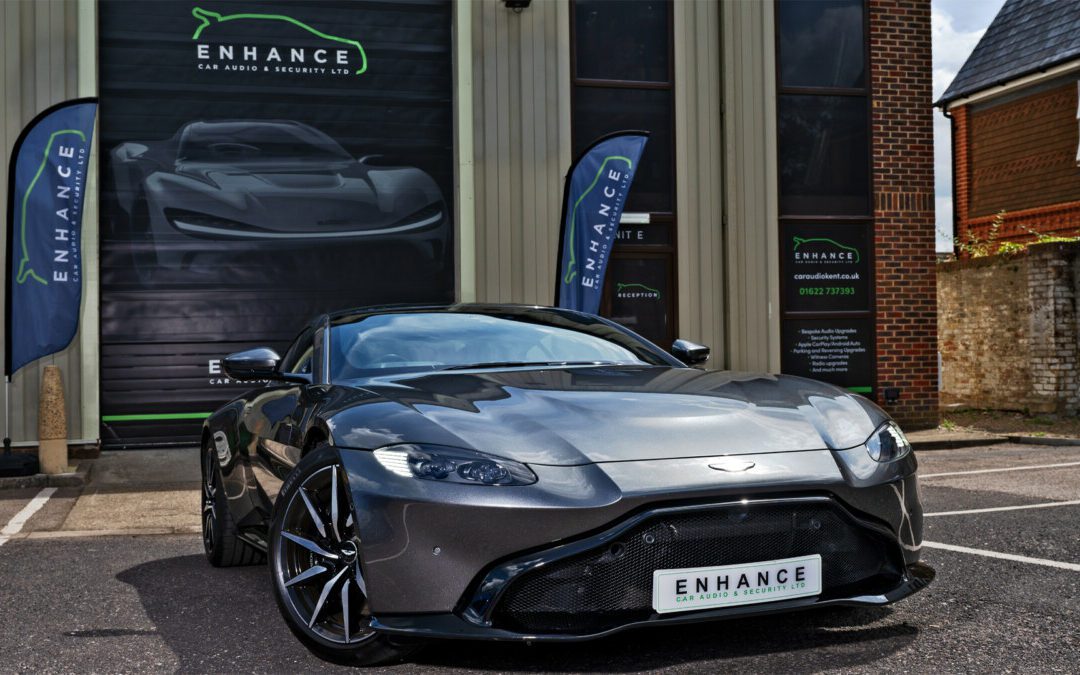Many owners considering aftermarket upgrade options for their in-car entertainment (ICE) system may be tempted to start by first upgrading the speakers, possibly followed by the amplifier as well. Given the poor quality of many factory-fit audio components (eg lightweight plastic and paper speakers), speaker and amplifier upgrades alone may result in significant improvements to the quality of music presentation (eg deeper bass, increased treble, increased soundstage, and a reduced noise floor), however, the owner is unlikely to unlock the full potential of these upgrades until they also consider what is being used to feed music into the amplifier & speakers. Only by considering all components in the audio path (including the source) does the music-loving motorist stand a chance of achieving an effective upgrade, yet despite this, the music source is frequently overlooked. This is the so-called ‘garbage in, garbage out’ philosophy, where the weakest link (in this case, the source) will restrict overall audio quality improvement.
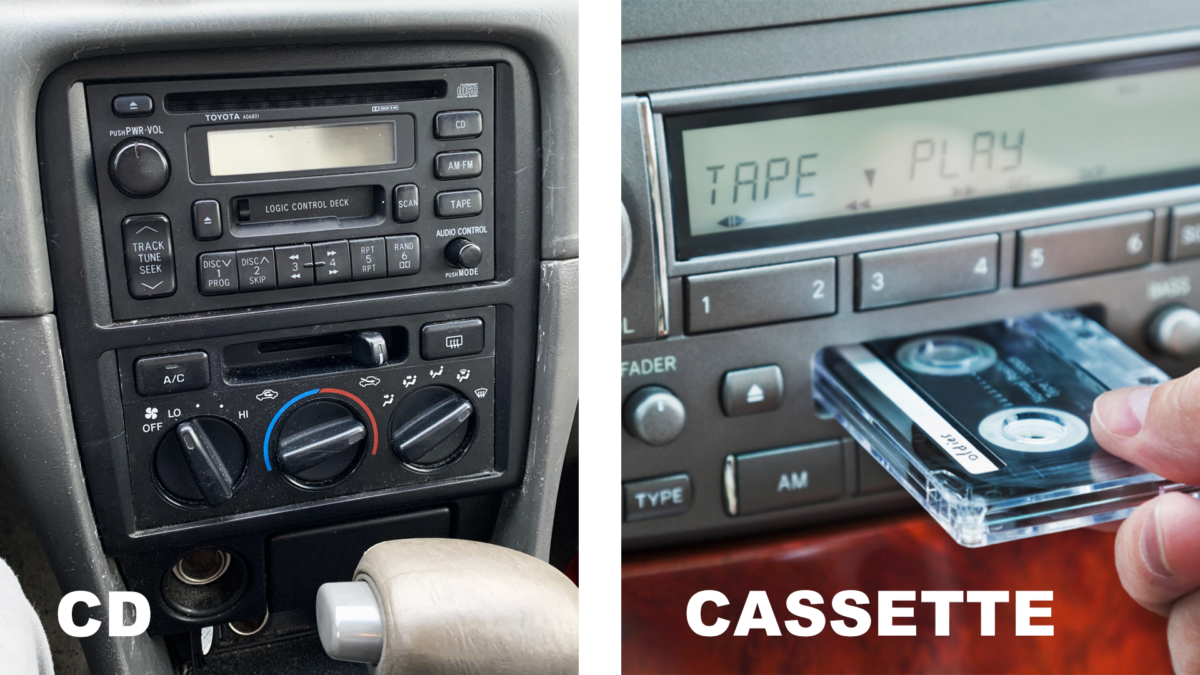
Until the early 2000s, vehicles were typically fitted with a radio cassette or radio Compact Disc (CD) player (with possibly a 6-disc Car CD Changer in the boot/trunk), however, manufacturers then started to fit iPod (mp3 player) interfaces to their ICE systems, offering the convenience of having the availability of hundreds of albums in the car. Today’s motorists however expect their vehicle’s audio system to integrate seamlessly with their mobile phones, often controlled by Apple CarPlay or Android Auto interfaces in the manufacturer’s head unit. Music replay in the car is then achieved using either music stored on the phone or via a music streaming service (such as Spotify or Apple Music) delivered wirelessly (Bluetooth/WiFi) or via a USB cable into the car’s head unit. In addition, many cars may have connected USB ports, allowing music or video to be played directly from a USB memory stick).
The downside (and cost) of the convenience of music replay from a phone is a loss of music quality, which is often significantly inferior to that obtained by CD playback. In order to condense so much music onto the phone’s memory, the music files are frequently compressed and ‘lossy.’ Whilst for many people, taking a hit on the quality of the music is an acceptable compromise in return for having the convenience of a large, on-board, music library, there is a growing demand from music-loving customers for quality as well as convenience. Much of this demand for improved quality music has been driven by people experiencing high quality (uncompressed and non-lossy) music reproduction in their homes (driven by streaming services featuring uncompressed music such as Tidal or Qobuz), the recent resurgence and interest in vinyl records as well as people’s raised expectations of overall higher audio fidelity and music playback. The days of music replay from cheap, tinny iPod docks are well and truly behind us!

What Does ‘lossy’ Music Mean?
Music replay from devices like iPods or mobile phones typically uses highly compressed “lossy” mp3 music files, where the music file has had much of its information stripped out (in order to save storage memory). Imagine if a “lossless,” quality digital music file (such as a track from a CD) was a loaf of bread, then a typical “lossy” mp3 file will be like taking 3/4 of that loaf and throwing it away. Yes, the music file will be smaller (allowing more music to be stored on a mobile phone), however much of the nuance, instrumental and vocal details of the music will have been discarded (CD utilises a bit rate of 1411kb/s, whilst the highest quality mp3 is capped at 320kb/s – less than a quarter of the original). Another analogy can be found by comparing low-definition video from a VHS video cassette (akin to mp3 quality) with the far clearer (less pixelated) picture offered by a ‘High Definition’ Blu-ray disc on an HD TV (akin to CD quality)! Imagine going back to watching films from a videocassette, where the lack of detail, colour and resolution would be unacceptable to many nowadays I suspect. The same is true with music – once you have heard quality music reproduction, it’s difficult to return to listening to lower-quality music fidelity.
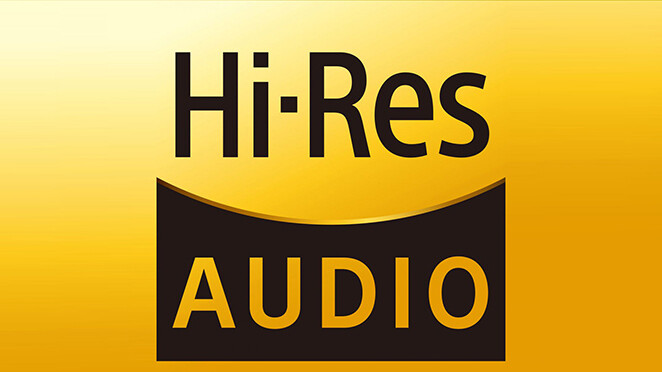
So, What Is High-Resolution Music?
High-resolution (Hi-Res) audio has been defined by the Digital Entertainment Group, Consumer Electronics Association & The Recording Academy, together with record labels as “lossless audio that is capable of reproducing the full range of sound from recordings that have been mastered from better than CD quality music sources.”
Practically, this means any music file that is of a higher sampling frequency &/or bit depth than a CD (16bit/44.1kHz). The sampling frequency is the rate that a signal is sampled – typically, the higher the sampling rate, the more accurately the signal sine wave can be reproduced, and the more similar will be the music to the original recording. Increased bit depth will also increase how accurately the signal is measured, resulting in increased fidelity of reproduction of the music. In practice, this leads to Hi-Res music files being 24bit and 96kHz or 192kHz (see Table 1 below). Bit rate is calculated as bit depth x sampling frequency x number of channels, and Table 1 shows some examples, with the higher bit rates resulting in a signal that is closest to the original recording (higher fidelity);

Whilst CD-quality files occupy more storage space than lossy files, Hi-Res music files (often in FLAC or WAV format) occupy even more storage space, with the example that a 24bit/192kHz file will take up 6.5 times more space than an equivalent CD file. The cost of storage is now significantly cheaper than previously however (making Hi-Res storage more realistic), whilst additionally, streaming music from high-quality streaming services (eg Tidal or Qobuz) means that the files do not have to be stored on your phone (should your phone have little to no spare memory).
How Can I Experience In-Car Hi-Res Audio?
There are many ways in which Hi-Res and/or high-quality music can be enjoyed in-car, including;
Replay of lossless and Hi-Res music directly from a USB memory stick or SD Card into the factory (OEM) system.
(You need to make sure that the OEM head unit can play these files directly without ‘down-sampling’ or compressing the music). Some Digital Audio Players (such as Astell & Kern, Fiio, iBasso, etc.) also have analogue line out (3.5mm socket), or Co-ax/Optical SPDIF/TOSLink outputs that it may be possible to connect to your car’s system.
Dedicated in-car Hi-Res streamer.
The use of Bluetooth to wirelessly stream music from a phone (or Digital Audio Player) to the car is very popular (driven by the trend of phone manufacturers to omit the headphone socket), however music-lovers should be aware that different Bluetooth codecs have different bandwidths (bit rates) that will directly affect the quality of music, and all Bluetooth transmissions are lossy in nature (data is discarded). Usually, the higher the Bluetooth bandwidth, the higher the rate of data transfer. Table 2 shows some examples, with aptX HD and LDAC (Hi) Bluetooth codecs offering the highest bandwidth (lowest degrees of compression) achievable today.

By convention, all Bluetooth devices must be able to use the (lowest bit rate) SBC codec, whilst Apple iPhones additionally use AAC and Android phones (and Android-based) Digital Music Players use the higher bit rate LDAC codec(s). Note that it is not currently possible to use LDAC on iPhones.
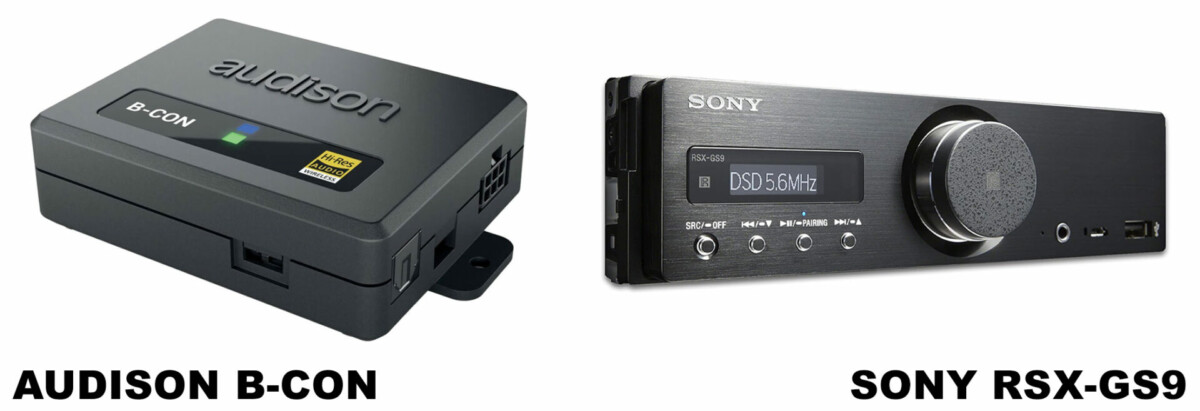
Two examples of dedicated in-car Hi-Res streamers (both using LDAC (Hi)) are; the Audison B-Con Hi-Res Audio 24bit/96kHz Bluetooth Receiver and the Sony RSX-GS9 Hi-Res Audio Media Receiver with Bluetooth. Both these units have obtained the Hi-Res audio wireless certification from JAS (Japan Audio Society).
Good as the technology is, however (and as the Table above shows), it is not currently possible to stream lossless, uncompressed, ‘bit-perfect’ Hi-Res music using Bluetooth. This is set to change in the future, with many audio companies searching for solutions. Watch this space!
Replacement of the factory head unit.
Replacement single or double Din head units for many cars is available from Alpine, Pioneer, Kenwood (etc.) that can play lossless and Hi-Res music. As an example, the newly released Alpine Halo9 iLX-F905D (9-Inch Media Receiver) can replay Hi-Res music directly from its own internal Tidal software.
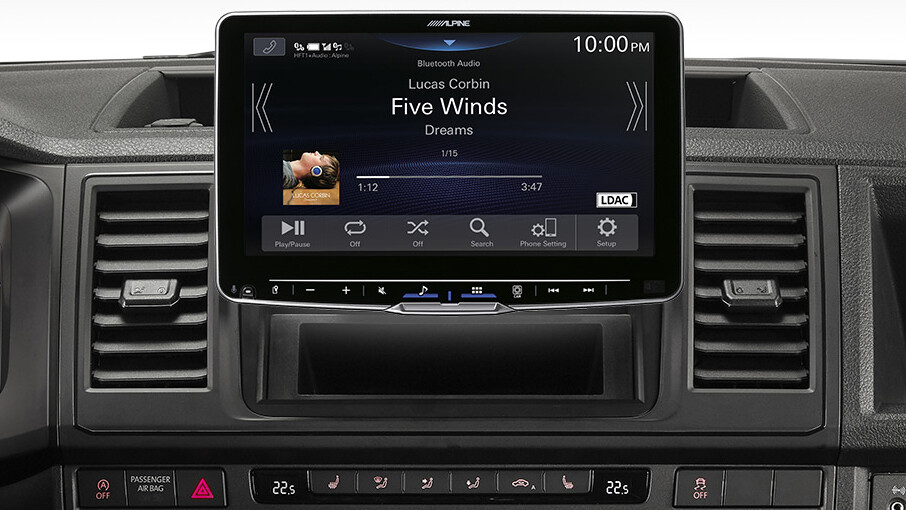
Units with Apple CarPlay or Android Auto interfaces will allow replay of music from a phone, however, to ensure the highest quality music reproduction (not necessarily lossless or Hi-Res), a wired connection should be used in preference to Bluetooth (for the reasons given in point 2 above).
Examples Of In-Car High-Res Audio Installations
The owner of this 2019 Aston Martin V8 Vantage (who enjoys high-quality music playback at home) was very disappointed with the music reproduction from Aston’s factory fit ‘premium audio’ package, which produced very poor-quality audio (distortion at higher volumes, ‘wooly sound’ (lack of treble & bass), no sound stage and a high ‘noise floor’). During the installation, it became apparent that the factory install utilised poor quality components (eg ultra-light plastic and paper generic speakers with small ferrite magnets – not the far better metal-caged speaker utilising neodymium magnets) and an under-powered, distorted amplifier. Also, there was little to no sound deadening fitted anywhere (this was rectified during the upgrade), one speaker had even been covered over.
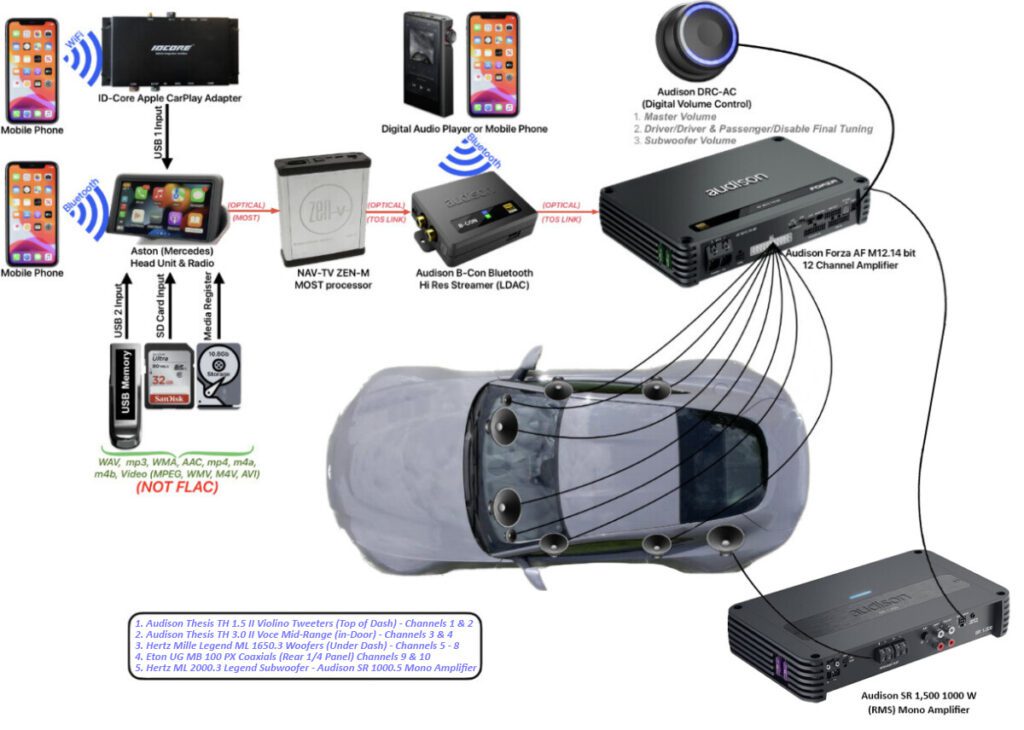
The above diagram shows the final upgraded installation and allows music playback in several different ways. Higher quality music playback is achieved with either WAV files played into the factory head unit (using CD and Hi-Res quality WAV files on a USB stick) or via the owner’s Astell & Kern Digital Audio Player (Kann Max) playing Hi-Res FLAC files into the Audison B-Con streamer. Streaming to the B-Con, allows direct connection of the music to the Audison amplifier, circumventing the car’s head unit, and avoiding any intrinsic bias or distortion to the sound. The increased fidelity from the upgraded system is staggering, and whether jazz, classical, rock or electro-funk is playing, the system sounds natural and balanced. The treble is full (but not sibilant), the mid-bass is well weighted and produces a great low-end whilst overall the system offers a great holographic-like sound stage (you can place where the musicians are playing and feels like the artist is performing right in front of you) with good volume and no discernible distortion.
This actively driven system has been tuned and calibrated (using a real-time analyser and Audison’s bit Drive DSP Software) to ensure tonal balance and correct time alignment from each of the speakers, allowing the driver to select either a ‘driver-only’ setting or a ‘driver and passenger’ setting.
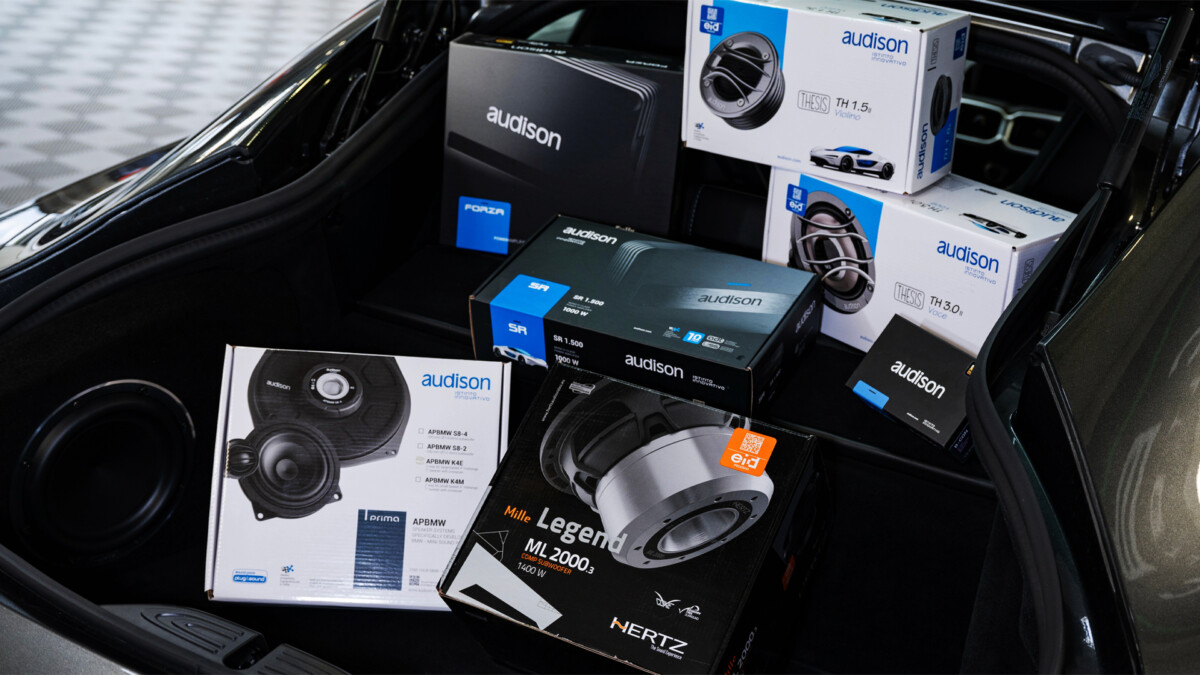
The upgrade journey for this Aston (and the owner) has been fascinating (in terms of perceptible audible improvements at every stage), and the (recently completed) final part of the upgrade was the replacement of the Aston factory-fit subwoofer (which sat in a plastic box behind the passenger seat) with a Hertz ML2000.3 Legend 8” subwoofer (housed in a custom boot-well mounted enclosure manufactured by Enhance Car Audio) amplified by an Audison SR 1.500 mono amplifier (1000W RMS).
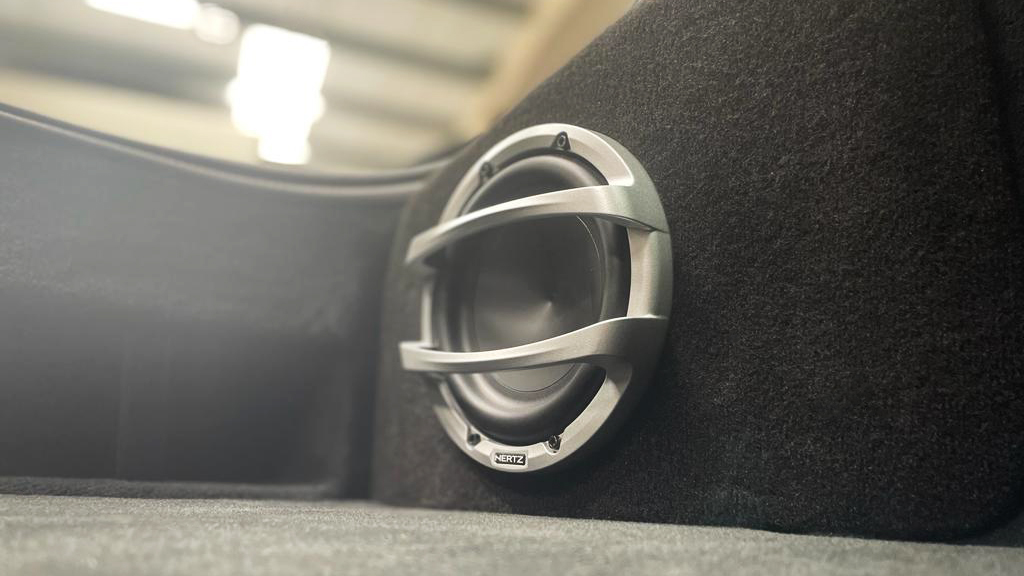
A Final Note…
The myth that ‘audio in a car will always be poor’ does not need to be the case. Agreed, the interior design of a car imposes some compromises, however, a properly installed and tuned after-market in-car audio system will (in most cases) significantly outperform any of these so-called ‘premium’ factory-fit packages.
It is highly recommended that you contact a quality in-car audio specialist installer (such as Enhance Car Audio & Security Ltd in Sittingbourne) who will work closely with you to design and build an audio upgrade (within your budget) that considers every component from signal to speaker and will be significantly better than the factory system in your vehicle.
Life is simply too short to suffer bad in-car audio! Get in touch today!
Written by G Johnson – customer and audio enthusiast

